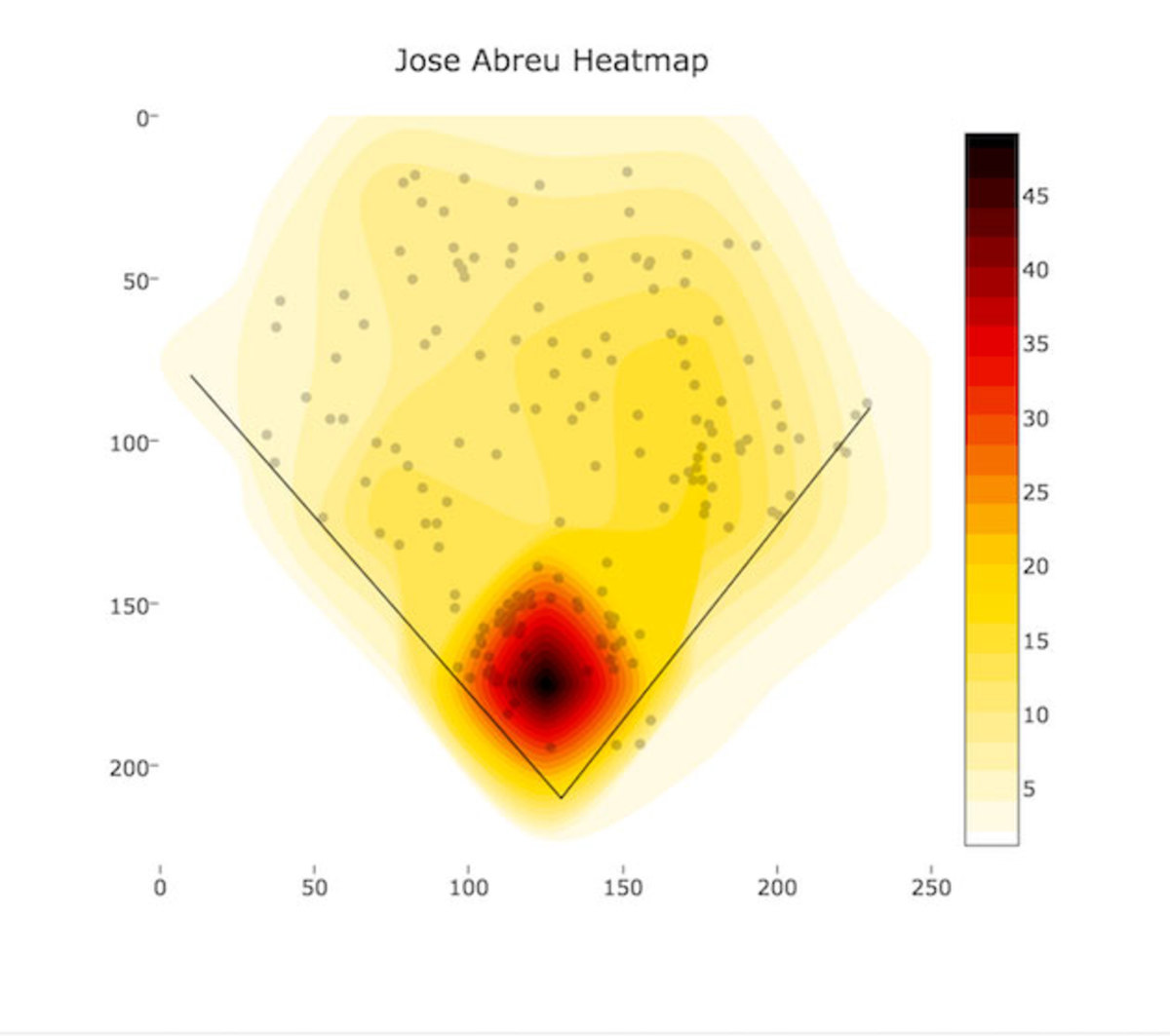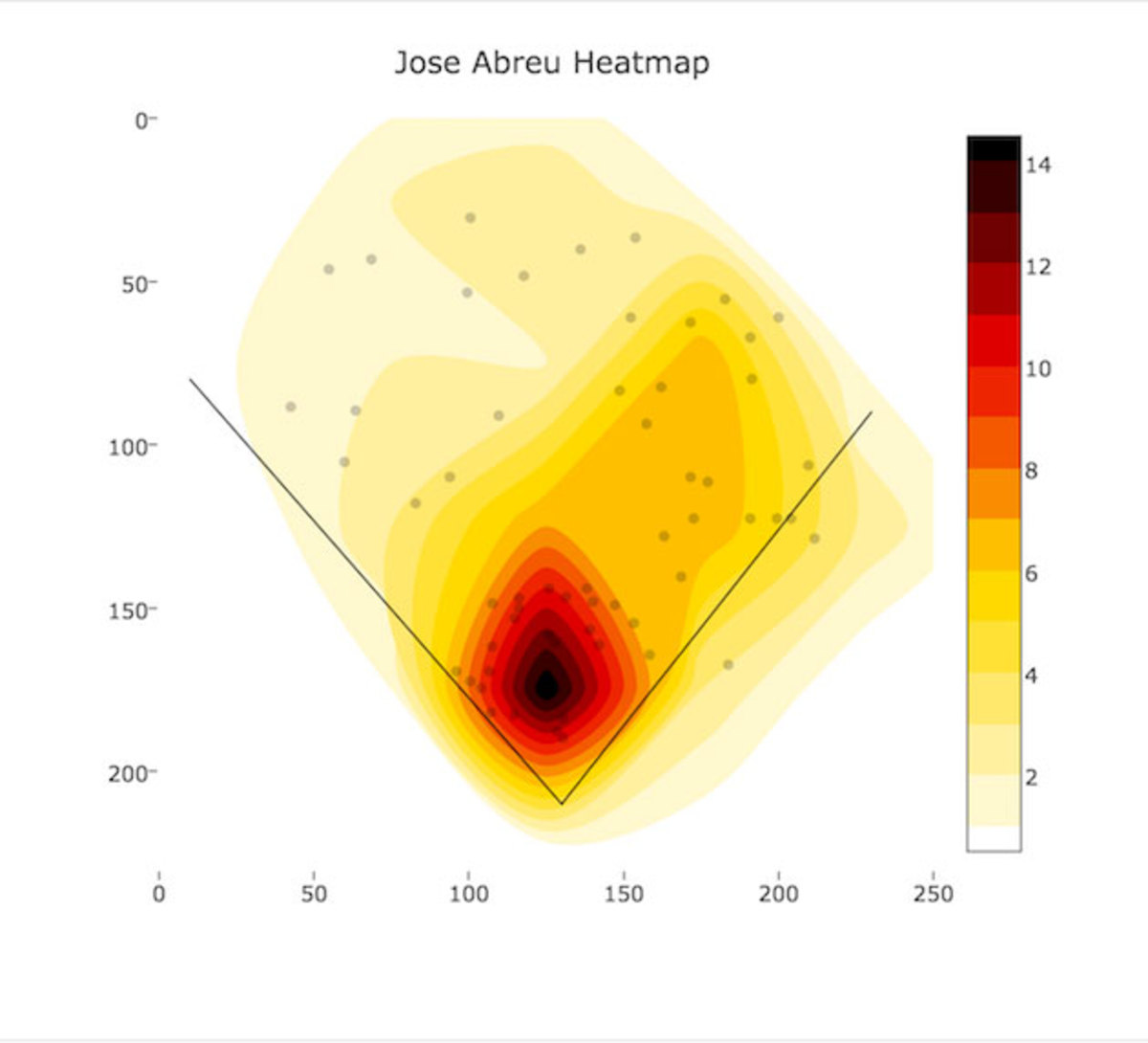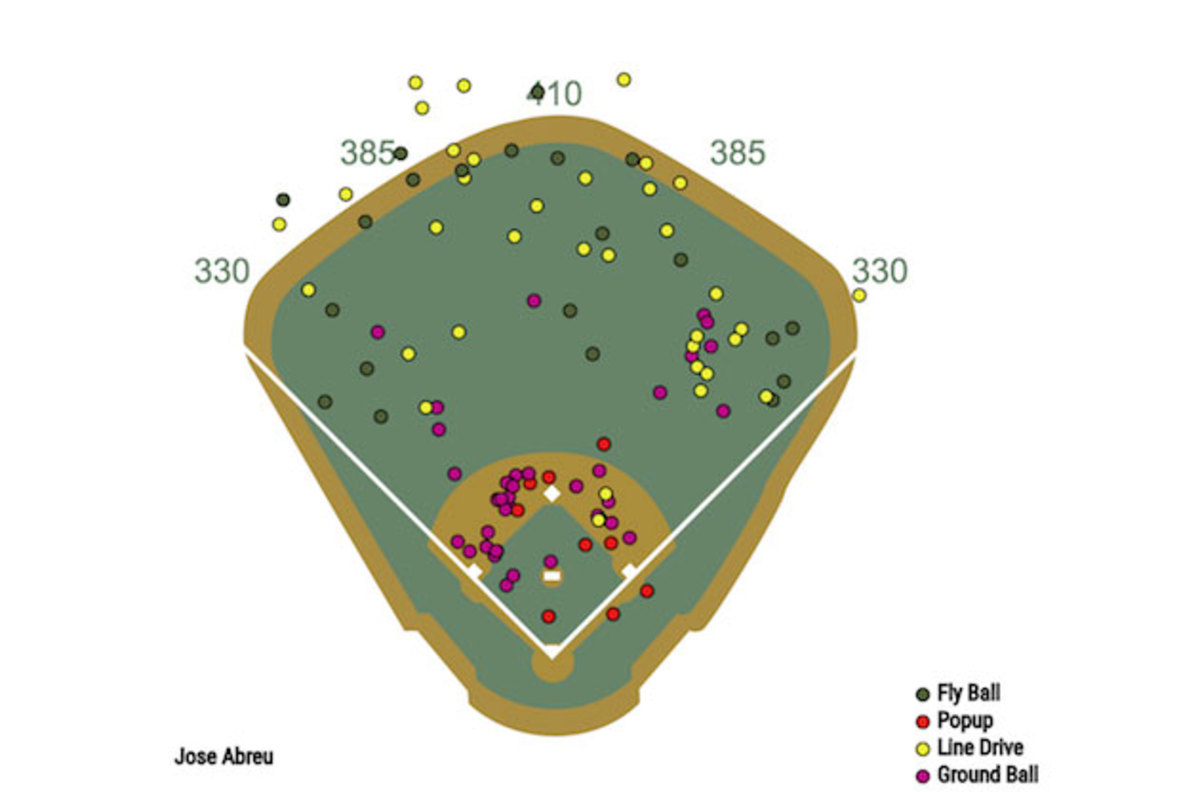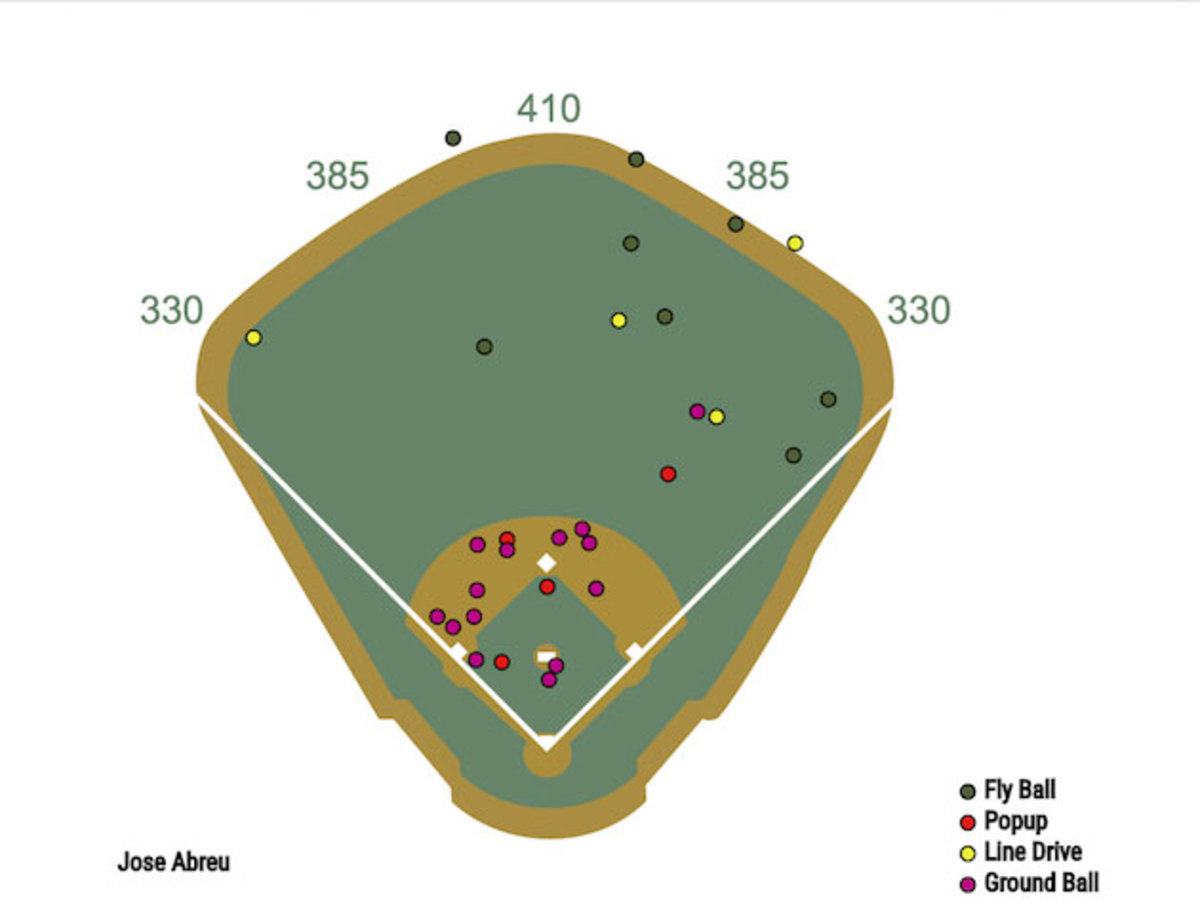Hitting Report: Just what happened to Jose Abreu's power?

The White Sox went 17–8 in April, finishing the month three games in front of the Tigers, four ahead of the Royals and five clear of the Indians. At that point, it didn’t much matter that Jose Abreu was hitting .229/.303/.354; in fact, it was a reason for optimism. If Chicago played that well with its best hitter at his worst, just imagine how the team would do when he finally came around.
Unfortunately for the White Sox, they went 11–17 in May, and things only got worse in the first week of June, as they dropped three of their first four games in the month, all at the hands of the division rival Tigers. Chicago, which began this week just a game over .500 and three games behind the Indians for first place in the AL Central, has lost nine straight games to fellow AL Central teams and is a combined 3–12 against Cleveland, Detroit and Kansas City.
The seemingly unending optimism surrounding Abreu at the end of April, meanwhile, essentially ran dry by the end of May. He hit .261/.314/.414 in the month and now sits at a .251/.310/.399 slash line for the season. It’s easy to preach patience with your star first baseman after a month when you’re exceeding expectations. It’s a whole lot harder when his slide lasts a second month and you’re barely over .500. In April, every conversation regarding Abreu’s struggles included the phrase “when he comes around.” Now that it’s June and things haven’t gotten any better, that “when” has turned into an “if.”
Pitching Report: Why it's time to make an investment in Danny Duffy
If you take a spin through Abreu’s underlying stats, you’ll undoubtedly notice something more than a little surprising. Most of the predictive ones are eerily similar to what they were in his first two excellent seasons. The numbers may not be identical, but there is not a significant difference in his strikeout, walk and swing-and-miss rates. His hard-hit rate is down a bit, but not to an alarming degree. His fly-ball and ground-ball rates are both up, siphoning a few percentage points from his line-drive rate to help explain the decline in hard-hit balls. Take it all into account, and—this is crucial—the sum of these minor changes cannot come anywhere near explaining what has happened to Abreu’s cosmetic stats this season.
Let’s turn our attention to Abreu’s fly balls, because his power is the main reason he was a top-20 pick this year. He’s not only hitting more fly balls this season, but he is also hitting them farther than ever before: His average fly-ball distance this season is 315.08 feet, good for fifth longest in the majors. Last year, he was at 307.79 feet, and his average fly ball flew 305.45 feet when he was a rookie. Nearly half the balls Abreu puts in play are in the air, and he hits them farther on average than all but four players in the majors. So how is it possible that he has a 10.5% home-run-to-fly-ball ratio, a figure less than half his career rate and down in a neighborhood typically reserved for the punchless likes of Adam Eaton and Joe Mauer?
The answer may lie in how and where pitchers are attacking Abreu. The Cuban slugger has never been a great hitter against inside pitches. Through his first two seasons, in which he hit 66 homers and had a total isolated slugging percentage of .237, his isolated power (his slugging percentage minus his batting average) on inside pitches—classified as either strikes on the inner-third or balls just off the plate inside—was .206 with 20 homers. That’s still quite good, but it doesn’t come close to measuring up to what he was able to do when he got his arms extended.
Fantasy baseball Waiver Wire: Young Trea Turner an infield solution
The problem was even worse against all types of fastball. When pitchers were able to attack Abreu with either a four-seamer, two-seamer or cutter inside, they turned him into a completely different hitter. His ISO on inside fastballs in his first two seasons was .166, and his ISO on all other fastballs was .269. That’s the difference between being Josh Donaldson (.271 ISO in 2015) and Salvador Perez (.166). Who would your rather face if you were a major league pitcher?
To be clear, Abreu’s issues with inside pitches generally and inside fastballs specifically aren’t new. Pitchers discovered this hole in his rookie season of 2014 and have been doing their best to exploit it ever since. The difference this season, however, is that they’re attacking him inside more than they ever did in his first two years in the league.
Abreu saw 876 pitches in the first two months of this season, with 45.4% of those on the inner-third or off the plate inside. In his first two seasons, a total of 39.1% of the pitches he saw were inside. In 2016, a whopping 56.7% of the fastballs thrown to Abreu have been designed to tie him up inside, compared with 47.1% in ’14 and ’15 combined.
A quick look at Abreu’s stance and swing should make it clear why he can have issues on balls near his body. Abreu starts out slightly closed, and then closes himself off just a bit more with his stride.
This is something Abreu will have to deal with—not just for the rest of the season, but also the remainder of his career. If he wants to get more pitches out away from him so he can let his arms breathe, he’s going to have to prove he can get his hands inside those fastballs on the inner-third and drive them with authority to the opposite field. We saw a few good instances of that in the White Sox' series against the Astros three weeks ago.
The problem is that these are still the exception, not the rule. It’s good for Abreu, just as it is for any hitter, to know how he’s being attacked. That’s not the only problem plaguing him in 2016, though. The following charts, courtesy of Baseball Savant and Statcast, show Abreu’s spray chart in heatmap form on pitches either down the middle or on the outer-third. These are the pitches he feasted on his first two seasons in the league. The first heatmap is from last year, and the second is from this year.


Abreu is no different than any hitter who has ever lived. He’s going to hit for more power when he pulls the ball, and he’s simply not doing so enough this season. It’s even worse when you isolate for just the three parts of the strike zone right down the middle of the plate. We have few enough data points in this one that the spray chart won’t overwhelm us.


Look at how few of those wheelhouse pitches he’s pulling this year compared with his first two MLB seasons. Abreu has pulled one pitch right down the middle of the plate with authority. Getting attacked inside helps explain his inconsistency and declining rates, but this is why his power numbers have fallen off this year. Combine the two, and it’s easy to see why Abreu did not live up to his end of the bargain for the first two months of the season.
Hitters to Watch This Week
Corey Seager, SS, Dodgers
Seager entered the Dodgers' weekend series against the Braves sitting on eight home runs this season. By time it was over, he had 13. That’s just the latest proof that the rookie is coming into his own in his first full season. One month ago, he was hitting .255/.331/.391 with one homer. After Tuesday’s action, his slash line is at .283/.340/.526. Over the last 30 days, no one in the majors has hit more homers than Seager’s 12. He’s one of two shortstops in the top three in isolated slugging, homers, runs and RBI at the position; the other is Manny Machado. It won’t be long before Seager is a bona fide member of the superstar club.
Carlos Gonzalez, OF, Rockies
I don’t want to pat myself on the back too forcefully, but I pretty much called this Gonzalez hot streak in last week’s Buy, Sell or Hold column. He got it going at Coors Field but kept it rolling over the weekend at Petco Park, hitting three homers and driving in six runs. Over the last two weeks, Gonzalez is hitting .426 (20 for 53) with eight homers and 16 RBIs. The Rockies start this week with three games at Dodger Stadium, but return home for four games—a makeup game with Pittsburgh on Thursday and three-game set with the Padres beginning Friday—to wrap it up. Gonzalez, who’s hitting .307/.352/.634 at home this year, should keep on impressing.
Tyler Naquin, OF, Indians
The Indians suddenly have a gaping hole in the outfield with Michael Brantley on the DL and Marlon Byrd done for the year thanks to a 162-game PED suspension. Naquin, who spent the first six weeks of the season with Cleveland, got called back to the majors after Byrd was suspended and homered in the final three games of the Indians' four-game sweep of the Royals over the weekend, going 6 for 13 in four starts. In 82 plate appearances with the Indians this season, Naquin is hitting .338/.378/.545 with three homers, three doubles, two triples and seven RBIs. Chances are he’ll continue to play as long as he’s hitting, as no one in Cleveland’s patchwork outfield is really locked into a starting gig.
Jonathan Villar, SS, Brewers
It shouldn’t come as a surprise that I follow a lot of baseball-centric Twitter accounts. One of them belongs to FanGraphs’ Jeff Zimmerman. Jeff and I are in the same Tout Wars league, and while he’s ahead of me in the standings for now, I have a ton of confidence in Nolan Arenado and the boys to help me chase him down. That’s neither here nor there, however. Jeff is a great follow on Twitter, and something he sent out into the universe on Monday morning caught my eye:
Current leaders in home runs plus stolen bases pic.twitter.com/5DG0JmGxpY
— Jeff Zimmerman (@jeffwzimmerman) June 6, 2016
Who cares if Villar’s speed is doing the heavy lifting to get him to the top of that leaderboard? The fact that he has a rightful place on a list that includes Jose Altuve, Mookie Betts and Bryce Harper, among others, would have seemed impossible just one month ago. Villar has turned himself into a major fantasy asset and, unless the wheels completely fall off, he’ll be among this season’s best returns on investment.
Joey Votto, 1B, Reds
Guess who’s finally starting to hit? At the end of play on May 23, Votto was slashing .203/.341/.351, a line that makes me almost angry to see next to his name. Two weeks later, he’s up to .221/.345/.421. That, of course, still looks disgusting for a player of his caliber, but we’re not evaluating this from the viewpoint of the beginning of the season. Votto has 14 hits, including four homers and five doubles, in his last 12 games, accounting for 47.4% of his extra-base hits this year. We all know Votto is too good, and his skill set too resilient, for him to be this bad all season. It’s a strong likelihood that we are finally seeing him break out of a months-long malaise.
Prospect Watch
Alex Bregman, SS, Astros
I was going to take this opportunity to excoriate the Nationals for sending Trea Turner back to the minors, but that would have been a wasted effort. After all, what choice did they have? Sure, they could have kept their elite prospect in the majors and played him at shortstop every day instead of a guy hitting worse than .200 in Danny Espinosa, but did you see what he did in his first game? He had the audacity to get three hits, thus proving himself a base clogger. That’s an aggression for which Dusty Baker cannot stand, lest he offend the legacy of Neifi Perez. No, there is only one place for Turner, and it's back at Triple A.
Instead of getting fired up about that situation, let’s take a look at another one of the game’s brightest young shortstop prospects in Alex Bregman. The 22-year-old is hitting everything in sight at Double A Corpus Christi, putting up a .301/.409/.583 slash line with 12 homers, 10 doubles and more walks (26) than strikeouts (19). It’s clear that the LSU product and No. 2 pick in the 2015 amateur draft isn’t long for Double A, or likely the minors in general. So where does he go from here?
Hitting report: Ben Zobrist’s big year shouldn’t have been a surprise
You’re probably well aware of the fact that the Astros have the shortstop and second base positions pretty well covered for the next, oh, 10 to 12 years, or so. With Carlos Correa and Jose Altuve ensconced up the middle in Houston, Bregman is going to have to change either positions or teams. To that end, he has started playing third base in the minors. Bregman has logged seven starts at third this season, most recently last Friday. We see teams do this with prospects all the time, with Addison Russell a recent example. With Starlin Castro at short last season, the Cubs started getting Russell time at second base at Triple A Iowa. He would ultimately spend about three months as the team’s starting second baseman last year before taking over as the everyday shortstop in early August. The Astros could take a similar tack with Bregman.
Houston’s third basemen—largely an even split between Luis Valbuena and Marwin Gonzalez—rank 29th in the majors in wOBA and fifth in strikeout rate. The Astros understandably don’t want to stunt Bregman’s growth by promoting him too early, but it’s hard to say with a straight face that he’d be doing any worse than the Valbuena/Gonzalez duo. You can bet on seeing Bregman in the majors sometime this summer, though it might be late July or early August before that happens.
GIF of the Week
Just in case you read the above and thought, “Hey wait a minute, maybe the Astros will move Correa to third and stick Bregman at short,” think again.
Not a bad shortstop they've got in Houston, huh?
